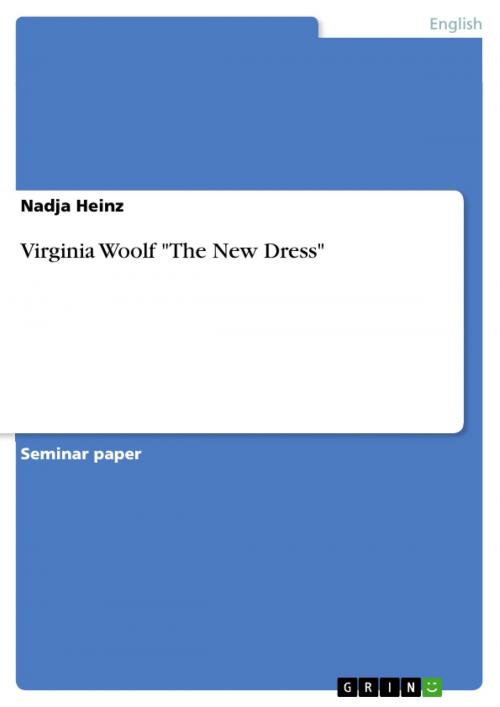| Author: | Nadja Heinz | ISBN: | 9783638486224 |
| Publisher: | GRIN Verlag | Publication: | April 4, 2006 |
| Imprint: | GRIN Verlag | Language: | English |
| Author: | Nadja Heinz |
| ISBN: | 9783638486224 |
| Publisher: | GRIN Verlag |
| Publication: | April 4, 2006 |
| Imprint: | GRIN Verlag |
| Language: | English |
Seminar paper from the year 2003 in the subject English Language and Literature Studies - Literature, grade: 1,7, http://www.uni-jena.de/, course: The British Short Story, 4 entries in the bibliography, language: English, abstract: 1. Introduction Virginia Woolf wrote the short story 'The New Dress' in 1924. It was made in preparation of her novel 'Mrs. Dalloway'. The same Mrs. Dalloway is the one giving the party in 'The New Dress'. It is a story about the feelings of a woman towards herself and her reaction to the behaviours of others when they meet her. The protagonist is Mable Waring, a woman at the age of 40, who is invited to a party at a friend´s house. Because of this occasion Mable´s dressmaker makes her a new dress, which Mabel has found in an old fashion book of her mother. She likes that yellow dress very much until she arrives at the party where she can see and feel how the other guests look at her. She starts to feel uncomfortable and searches for confirmation wherever she can. But Mabel does not get the confirmation she is looking for. During her stay at the party she has several flashbacks which remind her of the moments at the dressmaker Miss Milan and of her past. These moments make her happy but also aware of the situation she is in at the party which makes her sad again. At these occasions she always compares herself to a fly trying to get over the edge of a saucer. At the end of the story she thinks about changing her life and leaves the party with this new feeling. It is a bit difficult to understand all aspects of this short story completely. The reader has to read the story more than one time to really comprehend the strong feelings which are going on in the protagonists psyche. The stream-ofconsciousness technique which Virginia Woolf is famous for, makes the story more interesting and shows the reader the inside of Mabel. She also uses quite a few images which should be understood by the reader. The new dress and thus women's consciousness of fashion have to be considered. The protagonist Mabel is not a very strong character and does not have much selfconfidence, that is why she can be easily influenced by others. She uses flashbacks to escape the reality but these happy feelings are only temporary. At the end nothing has really changed for Mabel and she will always stay the way she is. [...]
Seminar paper from the year 2003 in the subject English Language and Literature Studies - Literature, grade: 1,7, http://www.uni-jena.de/, course: The British Short Story, 4 entries in the bibliography, language: English, abstract: 1. Introduction Virginia Woolf wrote the short story 'The New Dress' in 1924. It was made in preparation of her novel 'Mrs. Dalloway'. The same Mrs. Dalloway is the one giving the party in 'The New Dress'. It is a story about the feelings of a woman towards herself and her reaction to the behaviours of others when they meet her. The protagonist is Mable Waring, a woman at the age of 40, who is invited to a party at a friend´s house. Because of this occasion Mable´s dressmaker makes her a new dress, which Mabel has found in an old fashion book of her mother. She likes that yellow dress very much until she arrives at the party where she can see and feel how the other guests look at her. She starts to feel uncomfortable and searches for confirmation wherever she can. But Mabel does not get the confirmation she is looking for. During her stay at the party she has several flashbacks which remind her of the moments at the dressmaker Miss Milan and of her past. These moments make her happy but also aware of the situation she is in at the party which makes her sad again. At these occasions she always compares herself to a fly trying to get over the edge of a saucer. At the end of the story she thinks about changing her life and leaves the party with this new feeling. It is a bit difficult to understand all aspects of this short story completely. The reader has to read the story more than one time to really comprehend the strong feelings which are going on in the protagonists psyche. The stream-ofconsciousness technique which Virginia Woolf is famous for, makes the story more interesting and shows the reader the inside of Mabel. She also uses quite a few images which should be understood by the reader. The new dress and thus women's consciousness of fashion have to be considered. The protagonist Mabel is not a very strong character and does not have much selfconfidence, that is why she can be easily influenced by others. She uses flashbacks to escape the reality but these happy feelings are only temporary. At the end nothing has really changed for Mabel and she will always stay the way she is. [...]















